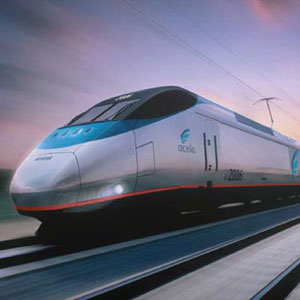High Speed Rail

Australia and Antarctica are now the only two continents in the world where there is no high speed rail project underway.
As part of the agreement to support the minority Labor government, the Australian Greens secured a $20 million feasibility study into high speed rail. That feasibility study demonstrated that it will cut pollution, enhance business and passenger transport and generate positive economic returns.
Melbourne to Sydney is one of the busiest air routes in the world. High speed rail could alleviate the need for a second Sydney airport. Once fully operational (from 2065 if we start planning now), HSR could carry approximately 84 million passengers each year, with express journey times of less than three hours between Melbourne-Sydney and Sydney-Brisbane.
Line 1: Sydney to Melbourne (2 hours 44 mins) comprising of Canberra to Sydney (1 hour) and Melbourne to Canberra (2 ½ hours).
Line 2: Sydney to Brisbane (2 hours 37 mins) comprising of Sydney to Newcastle (40 mins); and Newcastle to the Gold Coast and Gold Coast to Brisbane.
Once complete, the High Speed Rail would stretch 1,750km linking 11 major cities and regions all the way from Melbourne to Brisbane. The preferred alignment includes four capital city stations, four city-peripheral stations, and stations at the Gold Coast, Casino, Grafton, Coffs Harbour, Port Macquarie, Taree, Newcastle, the Central Coast, Southern Highlands, Wagga Wagga, Albury-Wodonga and Shepparton.
The estimated cost of constructing the preferred HSR alignment in its entirety would be around $114 billion (in 2012 dollars) which sounds like a lot of money until you realise it is what we hand out in ONE YEAR in tax concessions (estimated to grow to $150 billion per year in 2 years.)
HSR would substantially improve accessibility for the regional centres it served, and provide opportunity for regional development. It would allow cities to compete with each other. While Sydney might be more attractive at the moment, it is also much more expensive, so the opportunity to save costs by moving to regional areas that had easy access could be an option for some businesses.
Thousands of jobs would be created in the construction phase and, unlike roads, the HSR would provide ongoing employment for railway employees and associated industries.
Better transport connections mean reduced production and transport costs, higher productivity and greater competition between regions. Mobile phones and laptops now allow for business to be continued during train travelling time.
HSR will move millions of air and road trips on to rail. It will open up space on the existing rail network for freight, taking hundreds of heavy goods vehicles per hour off the roads. In so doing, It will also help cut carbon emissions.
The groundwork has been costed by the Parliamentary Budget Office at $664 million over the forward estimates period. This includes preparing a detailed financing and investment plan for the project, surveying the best rail corridors with the relevant state and local governments, securing ownership of those routes, and confirming the development and operation plan of the project through an inter-governmental agreement. The Environmental Impact statement (EIS) has been costed at $570 million. This seems a small amount to invest to ensure the viability and benefit of what seems a very worthwhile investment.
The Greens have already adopted this as a policy priority. I believe Labor should join them in making this a reality.
In August the ‘High Speed Rail Advisory Group’ chaired by former Nationals leader Tim Fischer found “no insurmountable issues that preclude Australia proceeding with high speed rail as a priority.”
That group was abolished by the Prime Minister in November.
Something to ponder: Some commentators argue that high speed rail is 20th Century technology. Video conferencing, apps like Hailo, and Google’s driverless cars are a cheaper and more up-to-date model for doing business and getting around. Then there’s the Hyperloop scheme suggested by PayPal founder Elon Musk. He claims it could propel pressurised capsules between Los Angeles and San Francisco in 35 minutes. I doubt that these are as relevant in Australia due to our huge distances but perhaps interesting thoughts for urban or interurban application.
Also by Kaye Lee:
Some of my best friends are corrupt
Like what we do at The AIMN?
You’ll like it even more knowing that your donation will help us to keep up the good fight.
Chuck in a few bucks and see just how far it goes!
Your contribution to help with the running costs of this site will be gratefully accepted.
You can donate through PayPal or credit card via the button below, or donate via bank transfer: BSB: 062500; A/c no: 10495969









